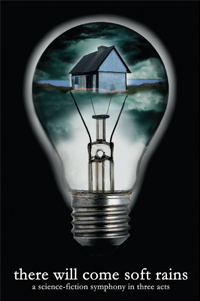One of the agendas I was excited about pursuing on tor.com is a drive to increase the visibility of speculative fiction theatre within the SF community, which is largely oblivious to the inventive stagings, vigorous workings-out, and brilliant explications that the stage has given to tropes that the SF crowd often considers its sole domain. Granted, the relative obscurity of theatre in the SF world is in large part due to access issues and to the ephemerality of the medium, but there’s enough work of worth and interest being developed that it seems a shame to let it go by without comment.
I could not have asked for a finer place to start the discussion than with There Will Come Soft Rains, a “science-fiction symphony in three acts” that has one performance left—tonight’s—in the New York International Fringe Festival. If you’re anywhere in the vicinity of New York City and are wondering what to do with your Saturday evening, I doubt there’s a better option than to show up at the New School tonight and stake your claim to a ticket for this stunning adaptation of three great science fiction short stories.
The show is based upon Stanislaw Lem’s “How the World Was Saved” (from The Cyberiad, which was first published in Polish in 1967 and in English, in a translation by Michael Kandel, in 1974), Barry Malzberg and Bill Pronzini’s “On the Nature of Time” (which appeared in Amazing in 1981), and Ray Bradbury’s “There Will Come Soft Rains” (from The Martian Chronicles, 1950). The crux of all three adaptations is to create an impressionistic tableau of the fantastical element rather than attempting to portray the crucial technology with special effects or complicated setpieces: in the first, a pair of puppet Constructers are transposed with a machine whose moving parts are animated by humans; the second uses tricks of the light to signify time travel; and, finally, a far-off future is built from whole cloth with simple household objects repurposed to stand in for an infinite variety of speculative robotics. Since these technologies are the focal point of their stories, the material goods supporting them take center stage, monopolizing the audience’s attention to glorious effect. This is in no means intended to be dismissive of the acting, cooreography, lighting, and sound design, all of which were quietly evocative, almost to the point where they blended together into the background and cleared the way for the puppets—and the language of the stories themselves—to take center stage.
The results were surprisingly soothing for such heady fare, mostly taking a quiet, reverent tone (quite in contrast, for example, to the trippily horrific approach taken in one prior adaptation of the Bradbury short, animated in Russia in 1984). If anything, I wondered if the show was too lulling at times, largely due to the fact that the sources for the first and last playlets were read in their entirety (or close to it) in cadences reminiscent of the standard delivery for children’s bedtimes stories, an approach that lent an absurdist sheen to any moments of violence subsequently tackled.
Aside from this uncertainty about tone, any other quibbles with the production—the gratingly cutesy voices taken on by the Contractors in Lem’s story, or the distracting fuzziness and breaks in the projections used in “Time”—were either minor, or attributable to and forgiven by the technical limitations that are unavoidable in a small-scale self-funded production like this. All in all, though, I can easily proclaim this to be the best show I’ve seen in my (admittedly limited) Fringe-going experiences over the past two or three years.
Of course, this brings to mind the show’s great insoluble flaw: all theatre is ephemeral, but Fringe especially so. It’s a shame that There Will Come Soft Rains was only scheduled for five performances, if only because it makes it difficult to tell everyone we know to go see it. There is a ray of hope in the fact that many shows have gone on to lives beyond the Fringe, and there’s a chance that this will be one of them. But even if that doesn’t turn out to be the case, at least we can eagerly await whatever Sinking Ship Productions tackles next.










